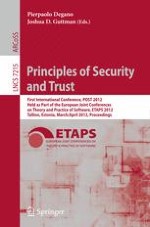2012 | Buch
Principles of Security and Trust
First International Conference, POST 2012, Held as Part of the European Joint Conferences on Theory and Practice of Software, ETAPS 2012, Tallinn, Estonia, March 24 - April 1, 2012, Proceedings
herausgegeben von: Pierpaolo Degano, Joshua D. Guttman
Verlag: Springer Berlin Heidelberg
Buchreihe : Lecture Notes in Computer Science
